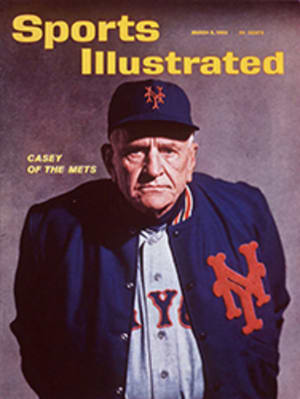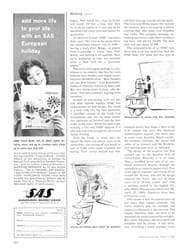
If golfers can do it, so can bowlers
Americans love to bowl, but when it comes to paying out money to see others do so, they couldn't care (or pay) less. In consequence, most full-time bowlers, like full-time skiers (SI, Feb. 26), have had to sustain themselves largely on pride and an occasional prize.
One nonbowling bowling fan, however, has long believed with all the tireless, backslapping, fast-talking energy in his restless frame that if other professionals can make a decent living at sport, bowlers should be able to do so too. Even before the pro skiers founded their own IPSRA, Eddie Elias was working on the Professional Bowlers' Association, patterned on golf's PGA. "But we didn't make the mistakes the PGA did," Eddie will tell you, "and we zoomed along four times as fast." Eddie, a swarthy, Arabic-speaking Ohio boy who calls people "Cuz" or "Cousin," believes that bowlers are "the most intelligent of athletes," also "the most appreciative, the most cooperative, the most gentlemanly. A few things the pro golfer is not. Bowlers are good boys." To help them, Eddie set up a whole series of three-and four-day tournaments to replace the six-month variety common to the sport. Then, besides setting up tours with respectable prize money for the winners and. lining up TV shows for the elite of the PBA's 800 members, he furnished his bowlers with a life insurance plan, a pension fund and health and accident insurance. "Everything is optional," says Eddie. "We're no dictatorship."
Besides caring for their needs, the PBA nurses its members' self-respect by fining them $10 for showing up late in the paddock, $25 for not wearing their names on the backs of their shirts and $10 for giving out autographs during competition. The money goes into a pension fund. "Mainly we're interested in raising the stature of the bowler," says Eddie. "We didn't think up the idea of calling alleys 'lanes' and gutters 'channels,' but we're in favor of it."
One for the money
A former radio interviewer and announcer (at one time busy Eddie was doing 20 TV shows a week), Elias got the idea for the PBA while chatting with Don Carter and Dick Hoover on one of his shows. "When I found they didn't have an organization behind them like the PGA," he says, "I was stunned. I told them I'd like to chuck TV and start one, and that got things rolling. I talked with bowlers, the American Bowling Congress, bowling center proprietors and the two big pinsetter firms, and nearly went broke writing letters urging bowlers to join. I drew up a constitution, giving bowlers plenty of representation on the executive board. 'I'm in it for the money,' I told them, and that convinced them. I didn't want to be president, just executive secretary, treasurer and legal counsel. Don Carter, the champion of them all, was our first president. In our first full year we had three tournaments, the second we had seven, the third we had 11. Last year we had a tournament in Puerto Rico, near San Juan, where they go absolutely crazy when you get a strike and die when you get a 7-10 split."
The PBA's initiation fee is $50, and annual dues are $100. These days prize money for tournaments is raised by charging bowlers an entry fee of $100 and getting some extra dollars ($10,800 minimum) from the proprietor of the lanes in which the tournament is held. The average prize for a PBA tournament is about $25,000, with the first 32 earning a piece of it and the winner getting around $5,000. Dave Soutar, who won last year's PBA championship in Cleveland, got $6,000—a good sum, but still only about three times what Eddie Elias spends each month on telephone bills to make it possible.
Eddie practically lives on the phone. "I have perfect recall for phone numbers," he said, holding his hand over the mouthpiece during a recent tournament while the pins fell with a clatter on all sides. "I even remember area codes and long distance codes." He rattled off a string of numbers, then gave his credit card number. Near by, a reporter was phoning in bowling scores, and other bowling scores boomed in triumphantly over the amplifier. It was a dizzying experience.
"I'm entirely different on the phone," Eddie said while waiting. "I talk slower. They tell me I'm warm. I went to Lebanon to set up a TV station in 1959. I was supposed to be there a month, but I only stayed two weeks. I couldn't stand it. No telephones. Once I nearly went crazy in an airport—all the booths were occupied." A bowler came by to set down his bowling ball.
"If they would've took out the 5-7 I would've been in good shape," he muttered darkly.
"I think you handled the situation very well," Eddie said absent-mindedly into the phone.
An assistant came in to say that some members of the fast-dying National Bowling League (SI, Oct. 30) would soon be joining the tour. Eddie nodded at the news. "Danny Thomas once told me," he said to the world in general, "never to give the customers too much. Always leave them wanting more. With the NBL there was just too much bowling. With us, it's three great nights in a city and whoosh! we're away till next year."
Eddie Elias does not smoke or drink, can drop off to sleep in minutes, does not need an alarm clock and has been too busy all his life to stop and figure out whether he is right-handed or left-handed. He plays tennis and golf right-handed and kicks a ball right-footed, but he throws left-handed and hits his best handball shot with his left hand. In baseball he was a switch-hitter. When he picked up his first bowling ball he didn't know which hand to use. He shortly gave up bowling, anyway. "My favorite sport is the cha-cha-cha," he says.
At high school, where Eddie was a starter on the basketball team, he developed rebounding ability and a firm place in the heart of his coach by skipping rope, to the amusement of spectators, all the way to school and back. "I always do things the hard way," he says.
The big thing
Whether professional bowlers as a whole will ever rate in status with the Arnold Palmers and the Gary Players is still an open question. If they do, however, it will be largely because Eddie Elias taught them—the hard way. In the middle of a phone conversation last week Eddie paused to tell of some trouble on the tour in California. "They were complaining all over the place out there," he said, "about the alleys and the conditions—and I jetted out from Akron immediately. I split them into three groups and saw each group separately. I was dressed very neat. When I walked in you could have heard a pin drop. If you couldn't hear a pin drop I would have walked right out. They didn't talk to me, they listened. I laid the cards right on the table. I said, 'I know you've got complaints and probably I agree with every one of them. But think it over. Is this the time—in the middle of a tournament—to make a big thing? Think what you can lose." And I let them think. 'Play now, complain later,' I told them. And, do you know, when I was finished they actually applauded. Then I turned and left—just what Danny Thomas said, right? But I love bowlers. They're my boys."
Then, once again, Eddie Elias poured himself into the telephone.
PHOTO
ELIAS ARGUES IN FAVOR OF THE BOWLER

